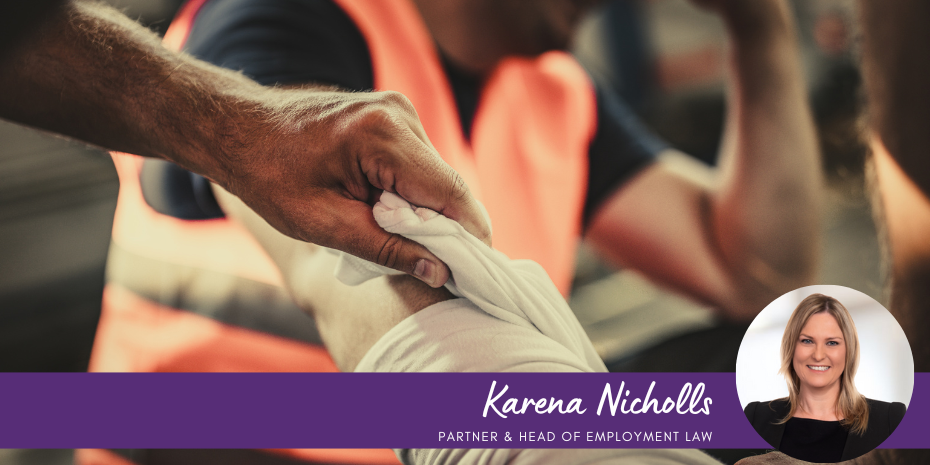KEY TAKE-OUTS:
- Suffering a workplace injury can cause great financial stress and pressure on an injured worker.
- It is important to know your rights and entitlements in relation to workers compensation weekly payments if you are unable to perform your pre-injury duties as a result of a workplace injury or illness.
- Any weekly compensation that might be payable to an injured worker who is unable to perform his or her pre-injury work duties is calculated by reference to their Pre-Injury Average Weekly Earnings or “PIAWE”.
- In this blog, we cover how you can calculate your pre-injury average weekly earnings to ensure you are receiving the correct weekly compensation payments.
What is PIAWE and why is it important for an injured worker?
When a worker loses time from work as a result of a work-related injury or illness, a worker may be entitled to weekly compensation when they can no longer perform their pre-injury employment. When this occurs, a worker may be paid a percentage of their pre-injury average weekly earnings (“PIAWE”).
PIAWE is defined in Schedule 3 of the Workers Compensation Act 1987 as “the weekly average of the gross pre-injury earnings received by the worker for work in any employment in which was engaged at the time of the injury”.
How is PIAWE Calculated?
The method by which a worker’s PIAWE is calculated will depend on the date of injury.
If a worker is injured before 21 October 2019
PIAWE is the average of a worker’s ordinary earnings during the relevant period and can include any shift and overtime amounts. This is calculated by adding the sum of a worker’s average ordinary earnings in the relevant period together and then dividing it by the number of weeks in the period.
Ordinary earnings include a worker’s base rate of pay or actual earnings, commissions, and the monetary value of non-financial benefits such as the use of a motor vehicle, health insurance and education. Shift and overtime amounts can only be included in the PIAWE if the worker performed shift/overtime during the relevant period or would likely to have continued to perform shift/overtime work during the 52 weeks after the date of injury.
The relevant earning period for a worker injured before 21 October 2019 is the period of continuous employment with the same employer for the 52 weeks immediately prior to the date of injury or the period of continuous employment with the same employer immediately before the injury, if the worker has been employed less than 52 weeks.
If a worker is injured on or after 21 October 2019
Ordinarily, PIAWE is the sum of a worker’s gross weekly earnings over the 52 weeks of employment before the date of the injury occurring. To calculate PIAWE, gross weekly earnings include earnings such as wages, including any paid leave and loadings, shift, overtime, and other allowances paid, commissions and piece rates. If a worker is employed by more than one employer at the date of injury, the earnings for all jobs are considered when determining PIAWE.
If a worker is an exempt worker
An exempt worker is a worker including a police officer, paramedic, and firefighter. Their weekly payment amount is calculated with reference to their average weekly earnings (AWE) or current weekly wage rate (CWWR). An exempt worker’s average weekly earnings are the average amount a worker was earning each week and includes overtime and shift allowances.
A worker’s current weekly wage rate applies when an agreement is in place that fixes a rate for a week or longer period. If no agreement exists between the worker and the employer, the CWWR is calculated to be 80 per cent of the average weekly earnings.
The formula for calculating a worker’s AWE or CWWR depends on the worker’s entitlement period and their capacity to work.
What if I have not been employed for 52 weeks? What if my earnings or work hours have changed?
In certain circumstances, the relevant earning period may be altered.
These circumstances can include the following:
- Where the worker has not been continuously employed in the 52 weeks before the injury, then the PIAWE is calculated based on the continuous period of employment immediately prior to the date of the injury.
- Where the worker has been employed for more than 4 weeks but less than 52 weeks, then the relevant period is the length of continuous employment.
- If the worker has been continuously employed for less than 4 weeks, PIAWE is calculated based on the earnings the worker would reasonably be expected to receive in the 52 weeks following the date of the injury.
- If a worker has been promoted to a new role during their employment or has had a change in hours or pay, then PIAWE is calculated from the period of continuous employment from the date the change took effect to the date of the injury.
- In the 52 weeks if the worker has taken unpaid leave, then the weeks must be excluded where a worker was on unpaid leave within the relevant period.
- In the 52 weeks before the injury, the worker has taken extended unpaid leave (7 or more days) is to be excluded from the relevant earning period.
- The worker had a reduction in earnings due to the COVID-19 pandemic’s impact on the employer, the worker can select up to two periods to be excluded from their earning period as the JobKeeper Scheme payments are not considered as earnings.
Example 1 – A worker injured before 21 October 2019
Ryan* is employed as a truck driver with a company called ‘Freight X’. Ryan injured his back at work whilst loading freight onto the truck.
Ryan has worked with Freight X for more than 52 weeks and is employed to work 40 hours per week. He is paid at an hourly rate of $35.36 gross for ordinary working hours and is paid $53.04 gross for overtime hours.
Ryan works in a two-week block. In week A, Ryan works 40 hours and earns $1,414.40 gross; in week B, Ryan works 44 hours and earns $1,626.56 gross. Ryan has worked this rotating two-week fortnight consistently for the 52 weeks prior to his injury.
Ryan’s PIAWE is calculated as follows:
Step 1. $1,414.40 gross x 26 weeks = $36,774.40 gross (Week A)
Step 2. $1,626.56 gross x 26 weeks = $42,290.56 gross (Week B)
Step 3. $36,774.40 gross (Week A) + $42,290.56 gross (Week B) = $79,064.96 (Gross Earnings)
Step 4. $79,064.96 (Gross Earnings) ÷ 52 weeks (Relevant Earning Period) = $1,520.48 gross per week
Therefore, Ryan’s PIAWE is $1,520.48 gross.
As Ryan has been injured before 21 October 2019, his overtime and shift allowances are included in PIAWE for the first 52 weeks only for which weekly payments are payable. After this time, overtime and shift allowances will be removed from his PIAWE calculation and recalculated as follows:
Step 1. $1,414.40 gross x 52 weeks (Relevant Earning Period) = $73,548.80 (Gross Earnings)
Step 2. $73,548.80 (Gross Earnings) ÷ 52 weeks (Relevant Earning Period) = $1,414.40 gross per week
Therefore, Ryan’s PIAWE after the first 52 weeks of weekly benefits will drop to $1,414.40 gross per week.
Example 2 – A worker injured on or after 21 October 2019
Sandra* is employed at a Child Care centre and injured her shoulder after tripping on toys whilst at work. Sandra had been employed with the Child Care centre for 48 weeks. During the 48 weeks, Sandra did not take any unpaid leave, did not perform any overtime, or shift work, and did not receive allowances or non-monetary benefits. Sandra’s PIAWE will be calculated based on the relevant earning period of 48 weeks. During this period Sandra earned a total of $43,852.67 gross.
Therefore, Sandra’s PIAWE is $43,852.67 (Gross Earnings) ÷ 48 weeks (Relevant Earning Period) = $913.60 gross per week.
Example 3 – An injured ‘exempt worker’
Thomas* is a NSW Police Officer and was injured during his employment.
Thomas worked 40 hours each week at an hourly rate of $40.86 gross and was employed for the 52 weeks prior to his date of injury. Thomas did not take any unpaid leave and earned a consistent amount of earnings per week.
Thomas’s Average Weekly Earnings are calculated as follows:
Step 1. 40 hours x $40.86 gross = $1,634.34 gross per week
Thomas’ Average Weekly Earnings will be $1,634.34 gross per week.
What Happens After my PIAWE is Calculated?
A worker will not receive 100% of their PIAWE amount underpayment of statutory weekly benefits. If liability has been accepted for your workers compensation claim, or if you are receiving weekly benefits under provisional liability, the amount of your weekly payments will be determined according to your PIAWE and the relevant sections under the Workers Compensation 1987 (NSW).
Can My PIAWE be Increased?
Yes. A worker’s PIAWE is to be indexed on 1 April and 1 October each year, pursuant to section 82A of the Workers Compensation Act 1987.
However, PIAWE cannot be indexed to a rate that is higher than the worker’s ordinary earnings had the injury not occurred. When making the comparison, the indexed PIAWE is compared to the current ordinary earnings but for the injury, exclusive of shift and overtime amounts.
For workers injured before 21 October 2019, this means any indexed PIAWE that includes shift and overtime amounts will ordinarily be higher, and so indexation will rarely be applied during the first 52 entitlement weeks.
What Do I Do If My PIAWE Has Been Calculated Incorrectly?
If a worker believes their PIAWE has been calculated incorrectly and as a result, they are receiving incorrect weekly payments, they can seek a review of their PIAWE to be completed independently through iCare, and if necessary, lodge an Application with the Personal Injury Commission for determination.
The calculation of PIAWE can be a complex and difficult process. If you are concerned about the calculation of your PIAWE or believe that you are not receiving your correct workers compensation entitlements, it is important to seek legal advice.
At Coutts, we can help. If you have been injured at work and need assistance with your workers compensation claim, please contact our office to arrange an appointment with a lawyer in our injury compensation team. We take the stress out of your claim so that you can focus on what is most important, your recovery.
**Please note, the names and examples used in this blog are fictional and do not relate to actual or real-life persons. This blog is merely general and non-specific information on the subject matter and is not, and should not, be considered or relied on as legal advice.
For further information please don’t hesitate to Contact Coutts today.
This blog is merely general and non-specific information on the subject matter and is not and should not be considered or relied on as legal advice. Coutts is not responsible for any cost, expense, loss or liability whatsoever to this blog, including all or any reliance on this blog or use or application of this blog by you.



